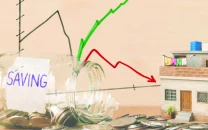Pakistan’s crisis: Let the rupee depreciate or increase tariffs – the billion-dollar question
Policy response to the situation is yet to show any semblance of clarity

Policy response to the situation is yet to show any semblance of clarity. creative commons
Although August brought some respite due to stronger exports, remittances and foreign direct investment; it remains to be seen if it is a one-off event or the start of an improving trend. Either way, challenges to Pakistan’s external sector remain far from over.
Unfortunately, policy response to the situation is yet to show any semblance of clarity. Earlier this month, the prime minister’s office was considering to depreciate rupee by 9% or Rs10 against US dollar or to increase the scope of 100% cash requirement before goods are imported.
Rupee sinks 3.2% against US dollar, Dar and SBP divided over explanation
However, Finance Minister Ishaq Dar opposed this proposal on the grounds that rupee depreciation will increase the burden of external debt on the federal budget. With the election year ahead, the government will naturally not want to compromise its already limited fiscal space. He has also opposed the 100% cash requirement option because the IMF raised objections when the move was previously used.
Ironically, the impact of both of these polices can be negative on the external sector. If rupee remains overvalued, as it is now, the import bill will remain high. Similarly, if rupee is depreciated, burden of external debt in rupee terms will be a cause of concern.
The government is mulling that the only way out of this apparent puzzle is to increase tariffs. The National Tariff Commission (NTC) has already identified 300 tariff lines of non-essential consumer goods on which it has proposed to increase duties by 30%.
As always, these goods include cosmetics, consumer goods, and agriculture products. As per the NTC, there is an added benefit of collecting revenue worth Rs26 billion for the government. However, per NTC proposal, duties will be abolished completely on import of raw materials and other materials that are used in manufactured exports. So what should the government do? Let the rupee depreciate to Rs115 vis-a-vis dollar or increase tariffs to the tune of 30%?
Tariff
Increasing tariffs on agriculture, cosmetics, and consumer goods can’t bring down Pakistan’s import payments in a comfortable range. The recent swift deterioration in current account deficit has come on the back of increased imports of power and construction machinery under the China-Pakistan Economic Corridor (CPEC). Increasing tariffs on goods that are not responsible for massive uptick in import payments can’t bring any dramatic improvement in our current account.
On top of that, our economy may run the risk of imported inflation especially in agriculture goods that we import. Pakistan’s major agriculture imports include edible vegetable, oil seeds, fruits, coffee, tea, and spices. While this policy may not reduce our import bill by a large margin, it may adversely decrease the purchasing power of consumers especially those who are poor and lower middle income since a significant portion of their income is spent on food items.
Rupee depreciation
It is widely believed that a depreciated rupee will give a push to Pakistani exports. Different business associations and economists have urged the government to depreciate it in order to give a temporary boost to exports. Even the IMF has continuously maintained that rupee is overvalued by at least 20%.
Dar’s concern about the implication of this policy on external debt can only make sense in rupee terms. But in dollar terms, rupee depreciation can reduce the dollar value of external debt.
According to the Economic Survey of Pakistan 2016-17, Pakistan’s external debt is $58.4 billion. If the rupee is depreciated to Rs115 per dollar, our external debt goes down to $53.2 billion. It is standard economics, whenever a currency loses value either due to inflation or depreciation, the debtor gains and the creditor losses.
On the other hand, depreciation may not be viewed favourably by long-term foreign investors since they prefer to invest in a currency in which their returns are secure. As Pakistan waits on the Emerging Market Funds to invest in the Pakistan Stock Exchange, rupee depreciation may render them nervous.
What should the government do?
Rupee depreciation can be the only viable and effective policy option in line with market fundamentals. However, it will only bring temporary relief to our external sector crisis. The fact that Pakistan is one of the few economies in the world, which repeatedly seeks help from the IMF for its external account crisis, warrants serious attention.
Rupee dip ‘meant to fix imbalances’
The real problem is that we have always been short-sighted in viewing our current account problems. We have always tried to plug this deficit either through more borrowing, remittances, or foreign direct investment — even privatisation proceeds. When inflows are not coming through these mediums, such as right now, we turn to options like rupee depreciation, tariffs and cash requirements.
A permanent end to the external account crisis can only be achieved through increasing our export earnings. For that, we need to scale down economic protection of industries as it has turned them uncompetitive in the global markets.
The writer is a researcher and works in the development sector of Gilgit
Published in The Express Tribune, October 9th, 2017.
Like Business on Facebook, follow @TribuneBiz on Twitter to stay informed and join in the conversation.


















COMMENTS
Comments are moderated and generally will be posted if they are on-topic and not abusive.
For more information, please see our Comments FAQ